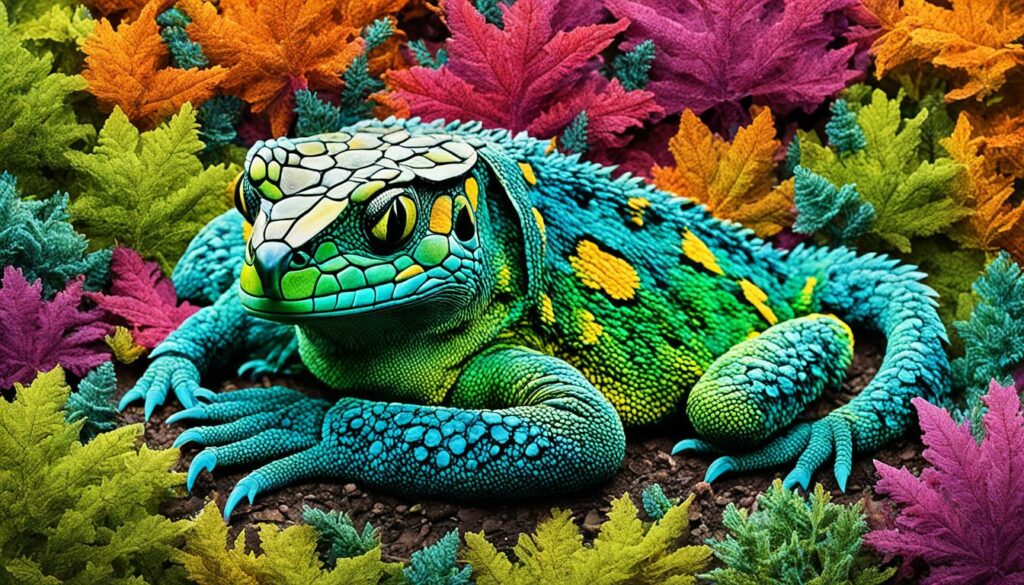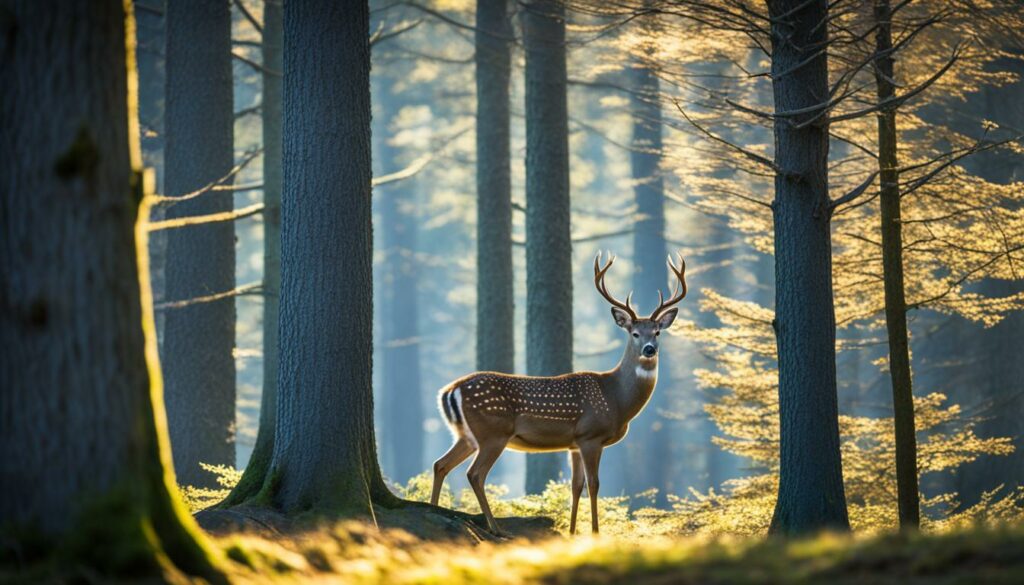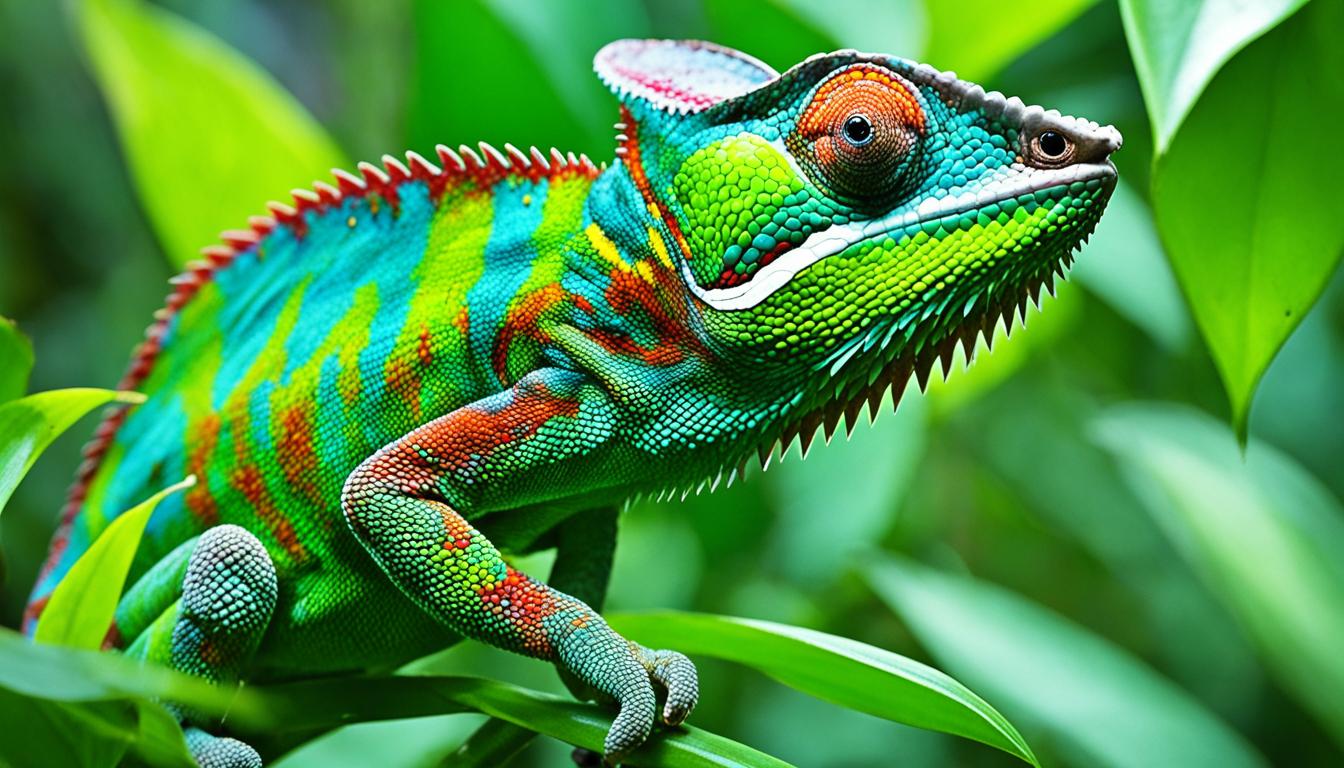In nature, the art of camouflage is amazing. It shows how smart the natural world is. Animals like the leopard blend into the trees with ease. The harlequin crab looks just like the coral reef.
This skill is key for many animals to survive. This article will explore how animals hide and blend in. It will show the science and amazing examples of camouflage that have been around for millions of years.
Key Takeaways
- Camouflage is a vital skill for survival in the wild, allowing animals to evade predators and approach prey undetected.
- The science of camouflage includes color and pattern matching, breaking up the outline, and utilizing shadows and lighting.
- Camouflage gear and accessories can enhance an individual’s ability to blend in with their surroundings.
- Techniques like staying still, utilizing shadows and lighting, and color matching are essential for effective concealment in the wild.
- Nature’s camouflage strategies range from disruptive coloration and mimicry to counter-shading and background matching, showcasing its evolutionary ingenuity.
Introduction: The Art of Invisibility
In nature, camouflage is key for survival. It lets creatures hide in plain sight. This part talks about the value of camouflage and its ancient origins. It shows how early humans learned to blend in and move quietly in the wild.
Understanding the Value of Camouflage
Camouflage is not just interesting; it’s vital for animals. It helps them hide from predators, catch prey, and move safely. This ancient camouflage technique shows how life on Earth is adaptable and smart.
The Ancient Origins of Camouflage
The story of camouflage goes way back to early humans. Our ancestors saw the value of hiding in nature. They wore earth-colored clothes and made patterns to look like their surroundings. These ancient camouflage techniques helped create the complex ways animals hide today. They teach us about the clever ways creatures survive in the wild.
“Camouflage is the art of invisibility, a timeless skill that has been honed by nature’s most ingenious creatures over countless generations.”
The Science of Camouflage
The art of camouflage is based on science. It uses color and pattern matching, and breaking up the outline. These methods help animals and humans blend in. They make it seem like they’re invisible.
Color and Pattern Matching
Color and pattern matching is key to camouflage. It means copying the colors and designs of the environment. This way, animals can look like they belong.
For example, the snowshoe hare changes its fur from brown to white with the seasons. This helps it blend in with the snow. The Saharan Horned Viper has special patterns that help it hide in the desert.
Breaking Up the Outline
Breaking up the outline is also important in camouflage. This is done with 3D camouflage. It adds textures and depth to make things look real.
The Ghillie suit is a great example of this. It makes the wearer look like part of the background. Hunters and soldiers use it to hide.
| Camouflage Technique | Description | Examples |
|---|---|---|
| Color and Pattern Matching | Replicating the hues and designs of the surrounding environment to blend in seamlessly | Snowshoe hare, Saharan Horned Viper |
| Breaking Up the Outline | Using 3D camouflage to create a visual illusion that disrupts the shape and size of the hidden object or individual | Ghillie suit |
Understanding camouflage science helps us blend in. It’s useful for survival, being sneaky, or for tactical reasons.
Camouflage Gear and Accessories
Modern tech has given us special camouflage clothing, gear, and accessories. These tools help us hide better in the wild. They include high-tech fabrics and things like the Ghillie Blanket.
Adaptive camouflage clothes change patterns and colors to fit the land. They make sure we don’t show up. Camouflage gloves, boots, face masks, and headgear help hide every part of us.
The Ghillie Blanket is great for wildlife watchers and photographers. It lets them hide and watch without being seen. You can add things like twigs and leaves to it for better hiding.
Anti-reflective optics are key for hiding. They reduce glare and help us see without being seen. This lets us watch without being noticed.
“Camouflage is not just about blending in – it’s about deceiving the eye and the mind, creating a seamless illusion that challenges our very perception of reality.”
Techniques for Effective Concealment
Camouflage is more than just matching colors and patterns. It’s about using special techniques to hide well in the wild. Hunters and observers use two main strategies: staying still and using shadows and light.
Stay Still
Moving too much can ruin your camouflage. It’s key to stay very still for a long time. This stops you from being seen.
Utilize Shadows and Lighting
Use places with lots of cover and light changes to hide better. Shadows and light help you look invisible. This makes it hard for others to see you.
Also, controlling your smell is important. Many animals use smell to find threats or food. Using scent-masking can help you hide better.
“The key to effective camouflage is not just about matching colors and patterns, but also mastering the subtle techniques that allow you to truly disappear into your surroundings.”
Camouflage techniques in the Wild
In nature, many creatures have learned to hide using camouflage techniques. The peppered moth changes color to hide, and the zebra’s stripes help it blend in. This is an ongoing battle between predators and prey.
The leaf-tailed gecko looks just like tree bark or leaves. This lets it hide from its food. Squid and octopuses can change color to hide too. They match their skin to their surroundings.
“Camouflage is not just about blending in, but about disrupting the outline and breaking up the silhouette of an animal.”
These camouflage techniques show how animals adapt and survive. As animals change, so does their need to hide. The outdoors is full of ways animals hide from each other.
- The peppered moth’s color-matching abilities
- The polar bear’s seamless blending with the Arctic landscape
- The zebra’s disruptive coloration pattern
- The jaguar’s spotted coat that helps it vanish in the rainforest
From deep oceans to dense jungles, animals have amazing camouflage techniques. These help them survive. By watching these animals, we learn about their amazing ways to hide. It shows us the constant change in nature.
Color Matching Mastery
Many animals use color matching to hide in their surroundings. This helps them avoid predators and sneak up on prey. It’s a clever way to stay safe.
Terrestrial Examples
The peppered moth changes its color to look like tree bark. This helps it hide from birds that might eat it. The polar bear turns white to blend in with snow. The leaf-tailed gecko looks just like tree bark or leaves.
Marine Examples
Sharks and penguins use a special trick called counter-shading in the water. Their dark backs look like deep water from above. Their light bellies look like the sky from below. This helps them hide from both predators and prey.
These amazing color matching camouflage tricks help many animals survive. They move through their worlds without being seen.

“Nature’s true masters of disguise, animals employ color matching with unparalleled skill, seamlessly blending into their surroundings to ensure their survival.”
Disruptive Coloration Wonders
Animals have come up with amazing ways to hide from predators and sneak up on prey. One cool trick is disruptive coloration. It’s like a magic trick for the eyes, making it hard to see individual animals in a group.
The zebra is a great example. Its black and white stripes make it hard to spot one in a crowd. The jaguar’s spots help it hide in the forest, making it hard to see.
Cephalopods, like squid and octopuses, are experts at changing their look. They can change their skin to match their surroundings. This helps them hide and talk to other cephalopods.
These examples show how animals have found clever ways to survive. By making it hard to see them, they get an edge in the wild.
The Marvels of Mimicry
In the world of nature, mimicry is a clever way to survive. It means an animal looks like another, often bigger and scarier, creature. This trick helps them hide and keeps predators away.
Harmless Deception
The king snake is a great example of mimicry. It looks like the venomous coral snake. This trick keeps predators away, thanks to the coral snake’s bad reputation.
The Kallima inachus butterfly looks like a dead leaf. The Alcon blue butterfly looks like a toxic butterfly. Both tricks help them avoid being eaten.
Interspecies Imitation
Underwater, mimicry is also amazing. Filefish look like lionfish to stay safe from predators. They use looks, sounds, smells, and actions to survive in the ocean.
Mimicry shows how animals have evolved to stay safe. From the king snake to the Kallima inachus butterfly, they use tricks to blend in. These examples show how nature is full of clever survival strategies.
“Mimicry not only provides visual deception but can also involve the imitation of sounds, scents, or behaviors, further enhancing an animal’s chances of survival.”
Counter-Shading Brilliance
In the world of camouflage, counter-shading is a top trick. It helps animals blend in. This trick is used by many, from sea creatures to land animals. It helps them hide from predators and sneak up on prey.
It works by using darker colors on top and lighter colors on the bottom. This makes the animal look flat, not three-dimensional. It’s like a magic trick to avoid being seen.
For sea animals like sharks, whales, and fish, it’s super useful. They can hide in the deep sea from above and match the bright surface from below. This helps them sneak up on food and avoid danger.
On land, deer, rabbits, and penguins use it too. They blend in with their surroundings. Whether it’s a sunny forest or snowy ground, they’re hard to spot.
Counter-shading shows how animals have adapted to survive. It’s a clever way to hide. Nature is full of amazing tricks like this.

“Counter-shading is one of nature’s most ingenious camouflage techniques, allowing animals to vanish into their surroundings with remarkable ease.”
Motion Camouflage Artistry
Motion camouflage is key for many creatures to survive. The praying mantis moves like the wind blows leaves. Owls stay still, looking just like tree bark.
The Arctic hare is great at this too. When danger comes, it doesn’t move. Its white fur looks just like snow. This way, it hides well and doesn’t give away its spot.
Camouflage is more than just looking the part. It’s also about moving in a way that doesn’t give you away. Creatures like these use special moves to stay hidden. This helps them survive in the wild.
| Camouflage Technique | Animal Example | Description |
|---|---|---|
| Motion Camouflage | Praying Mantis | Sways gently to imitate the movement of leaves in the breeze. |
| Stillness Camouflage | Owls | Remain perfectly still, their plumage blending seamlessly with the bark or leaves of their roosting trees. |
| Motionless Camouflage | Arctic Hare | Stay motionless when threatened, their white fur merging with the snowy backdrop. |
These examples show how motion camouflage, praying mantis camouflage, owl camouflage, and Arctic hare camouflage help creatures survive. They use movement, pattern, and color to stay hidden. This is how they master the art of being invisible.
“Camouflage is not just about physical appearance; it’s about the behavioral nuances that enhance an animal’s ability to remain undetected.”
Background Matching Masters
In the world of camouflage, some animals are true experts. They blend into their surroundings so well, they’re hard to see. The stonefish is a great example. It looks just like the coral and rocks under the sea.
The stonefish stays still and looks just like its home. The leafy sea dragon looks like seaweed. And the tawny frogmouth bird looks like tree bark.
These animals show how animals hide from predators. As predators get better at hunting, animals get better at hiding. The stonefish, leafy sea dragon, and tawny frogmouth show how far animals go to survive.
“Camouflage is the art of becoming invisible by becoming visible.” – Gerard Manley Hopkins
Nature is full of amazing ways animals hide. They blend in to stay safe from danger. Learning about background matching camouflage helps us appreciate nature more. It shows how animals are so good at surviving.
Conclusion: Nature’s Survival Theater
Looking at how animals hide in the wild teaches us more than just survival tricks. These hiding skills show us the symbiotic web of life. Each animal’s way of hiding affects others, changing how they hunt, find mates, and even shape their homes in ecosystems. For those who love nature, these animals show us how smart and important it is to keep our wild places safe.
The way animals hide is a great example of how life has gotten better at surviving over time. It shows us the fine balance in nature. When we see how well animals hide, we see how delicate and strong life can be at the same time.
Learning about how animals hide helps us value all living things and why we must protect their homes. It shows us the beauty and strength of nature in a new way. The art of hiding is a strong sign of nature’s beauty and strength.
FAQ
What is camouflage and how does it help animals survive in the wild?
What are the fundamental principles behind the science of camouflage?
What types of specialized gear and accessories can enhance human camouflage in the wild?
What are some key techniques for effective concealment in the wild?
Can you provide examples of how different animals use camouflage techniques in the wild?
Source Links
- Masters of Disguise: The Puff Adder’s Camouflage Secrets – https://www.needleslodge.com/blog/post/the-art-of-camouflage-natures-masters-of-disguise/
- Mastering Disguise: Top Camouflage Techniques in the Animal Kingdom | Curious Minds – https://www.wokewaves.com/posts/effective-animal-camouflage-techniques
- Mastering the Art of Stealth: Camouflage and Concealment in the Outdoors – https://silverantoutdoors.com/blogs/the-silverant-blog/mastering-the-art-of-stealth-camouflage-and-concealment-in-the-outdoors
